Fangzhi Xu
Genius: A Generalizable and Purely Unsupervised Self-Training Framework For Advanced Reasoning
Apr 11, 2025Abstract:Advancing LLM reasoning skills has captivated wide interest. However, current post-training techniques rely heavily on supervisory signals, such as outcome supervision or auxiliary reward models, which face the problem of scalability and high annotation costs. This motivates us to enhance LLM reasoning without the need for external supervision. We introduce a generalizable and purely unsupervised self-training framework, named Genius. Without external auxiliary, Genius requires to seek the optimal response sequence in a stepwise manner and optimize the LLM. To explore the potential steps and exploit the optimal ones, Genius introduces a stepwise foresight re-sampling strategy to sample and estimate the step value by simulating future outcomes. Further, we recognize that the unsupervised setting inevitably induces the intrinsic noise and uncertainty. To provide a robust optimization, we propose an advantage-calibrated optimization (ACO) loss function to mitigate estimation inconsistencies. Combining these techniques together, Genius provides an advanced initial step towards self-improve LLM reasoning with general queries and without supervision, revolutionizing reasoning scaling laws given the vast availability of general queries. The code will be released at https://github.com/xufangzhi/Genius.
$φ$-Decoding: Adaptive Foresight Sampling for Balanced Inference-Time Exploration and Exploitation
Mar 17, 2025Abstract:Inference-time optimization scales computation to derive deliberate reasoning steps for effective performance. While previous search-based strategies address the short-sightedness of auto-regressive generation, the vast search space leads to excessive exploration and insufficient exploitation. To strike an efficient balance to derive the optimal step, we frame the decoding strategy as foresight sampling, leveraging simulated future steps to obtain globally optimal step estimation. Built on it, we propose a novel decoding strategy, named $\phi$-Decoding. To provide a precise and expressive estimation of step value, $\phi$-Decoding approximates two distributions via foresight and clustering. Sampling from the joint distribution, the optimal steps can be selected for exploitation. To support adaptive computation allocation, we propose in-width and in-depth pruning strategies, featuring a light-weight solution to achieve inference efficiency. Extensive experiments across seven benchmarks show $\phi$-Decoding outperforms strong baselines in both performance and efficiency. Additional analysis demonstrates its generalization across various LLMs and scalability across a wide range of computing budgets. The code will be released at https://github.com/xufangzhi/phi-Decoding, and the open-source PyPI package is coming soon.
CapArena: Benchmarking and Analyzing Detailed Image Captioning in the LLM Era
Mar 16, 2025Abstract:Image captioning has been a longstanding challenge in vision-language research. With the rise of LLMs, modern Vision-Language Models (VLMs) generate detailed and comprehensive image descriptions. However, benchmarking the quality of such captions remains unresolved. This paper addresses two key questions: (1) How well do current VLMs actually perform on image captioning, particularly compared to humans? We built CapArena, a platform with over 6000 pairwise caption battles and high-quality human preference votes. Our arena-style evaluation marks a milestone, showing that leading models like GPT-4o achieve or even surpass human performance, while most open-source models lag behind. (2) Can automated metrics reliably assess detailed caption quality? Using human annotations from CapArena, we evaluate traditional and recent captioning metrics, as well as VLM-as-a-Judge. Our analysis reveals that while some metrics (e.g., METEOR) show decent caption-level agreement with humans, their systematic biases lead to inconsistencies in model ranking. In contrast, VLM-as-a-Judge demonstrates robust discernment at both the caption and model levels. Building on these insights, we release CapArena-Auto, an accurate and efficient automated benchmark for detailed captioning, achieving 94.3% correlation with human rankings at just $4 per test. Data and resources will be open-sourced at https://caparena.github.io.
Self-supervised Quantized Representation for Seamlessly Integrating Knowledge Graphs with Large Language Models
Jan 30, 2025



Abstract:Due to the presence of the natural gap between Knowledge Graph (KG) structures and the natural language, the effective integration of holistic structural information of KGs with Large Language Models (LLMs) has emerged as a significant question. To this end, we propose a two-stage framework to learn and apply quantized codes for each entity, aiming for the seamless integration of KGs with LLMs. Firstly, a self-supervised quantized representation (SSQR) method is proposed to compress both KG structural and semantic knowledge into discrete codes (\ie, tokens) that align the format of language sentences. We further design KG instruction-following data by viewing these learned codes as features to directly input to LLMs, thereby achieving seamless integration. The experiment results demonstrate that SSQR outperforms existing unsupervised quantized methods, producing more distinguishable codes. Further, the fine-tuned LLaMA2 and LLaMA3.1 also have superior performance on KG link prediction and triple classification tasks, utilizing only 16 tokens per entity instead of thousands in conventional prompting methods.
OS-Genesis: Automating GUI Agent Trajectory Construction via Reverse Task Synthesis
Dec 27, 2024Abstract:Graphical User Interface (GUI) agents powered by Vision-Language Models (VLMs) have demonstrated human-like computer control capability. Despite their utility in advancing digital automation, a critical bottleneck persists: collecting high-quality trajectory data for training. Common practices for collecting such data rely on human supervision or synthetic data generation through executing pre-defined tasks, which are either resource-intensive or unable to guarantee data quality. Moreover, these methods suffer from limited data diversity and significant gaps between synthetic data and real-world environments. To address these challenges, we propose OS-Genesis, a novel GUI data synthesis pipeline that reverses the conventional trajectory collection process. Instead of relying on pre-defined tasks, OS-Genesis enables agents first to perceive environments and perform step-wise interactions, then retrospectively derive high-quality tasks to enable trajectory-level exploration. A trajectory reward model is then employed to ensure the quality of the generated trajectories. We demonstrate that training GUI agents with OS-Genesis significantly improves their performance on highly challenging online benchmarks. In-depth analysis further validates OS-Genesis's efficiency and its superior data quality and diversity compared to existing synthesis methods. Our codes, data, and checkpoints are available at \href{https://qiushisun.github.io/OS-Genesis-Home/}{OS-Genesis Homepage}.
OS-ATLAS: A Foundation Action Model for Generalist GUI Agents
Oct 30, 2024
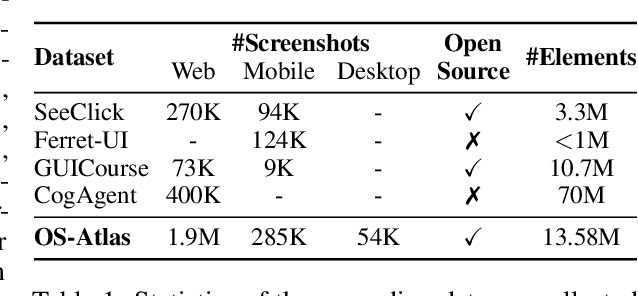
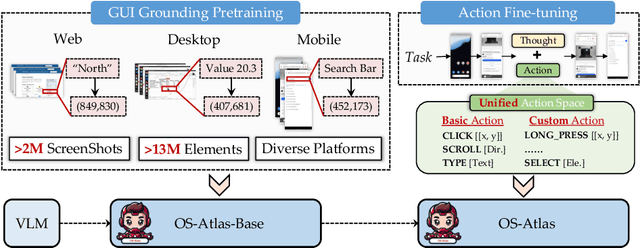
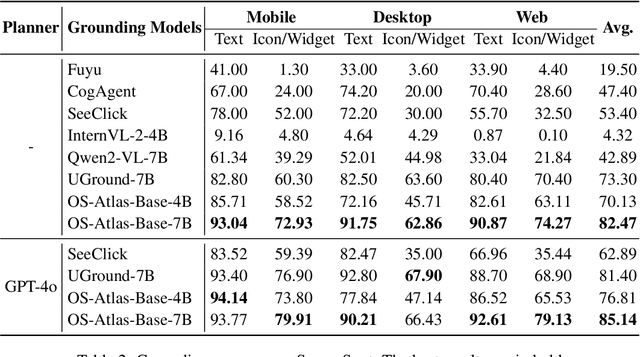
Abstract:Existing efforts in building GUI agents heavily rely on the availability of robust commercial Vision-Language Models (VLMs) such as GPT-4o and GeminiProVision. Practitioners are often reluctant to use open-source VLMs due to their significant performance lag compared to their closed-source counterparts, particularly in GUI grounding and Out-Of-Distribution (OOD) scenarios. To facilitate future research in this area, we developed OS-Atlas - a foundational GUI action model that excels at GUI grounding and OOD agentic tasks through innovations in both data and modeling. We have invested significant engineering effort in developing an open-source toolkit for synthesizing GUI grounding data across multiple platforms, including Windows, Linux, MacOS, Android, and the web. Leveraging this toolkit, we are releasing the largest open-source cross-platform GUI grounding corpus to date, which contains over 13 million GUI elements. This dataset, combined with innovations in model training, provides a solid foundation for OS-Atlas to understand GUI screenshots and generalize to unseen interfaces. Through extensive evaluation across six benchmarks spanning three different platforms (mobile, desktop, and web), OS-Atlas demonstrates significant performance improvements over previous state-of-the-art models. Our evaluation also uncovers valuable insights into continuously improving and scaling the agentic capabilities of open-source VLMs.
Vision-Language Models Can Self-Improve Reasoning via Reflection
Oct 30, 2024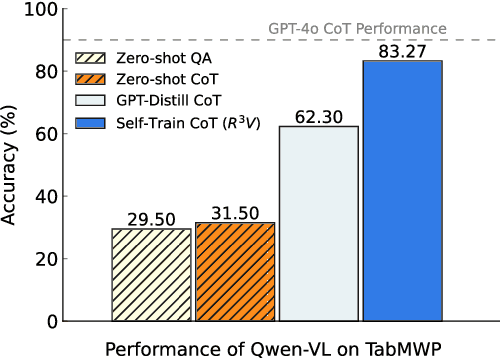
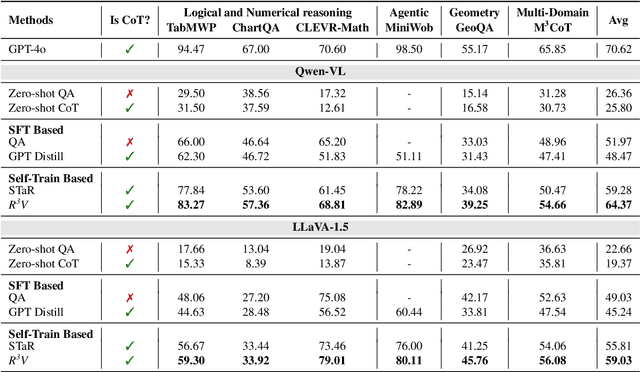
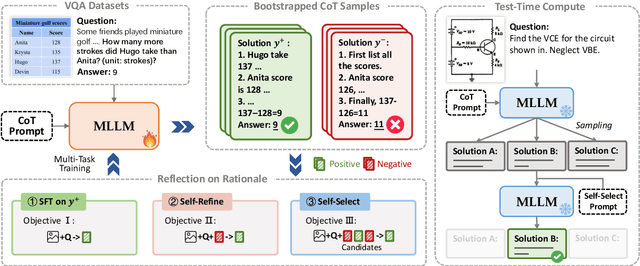
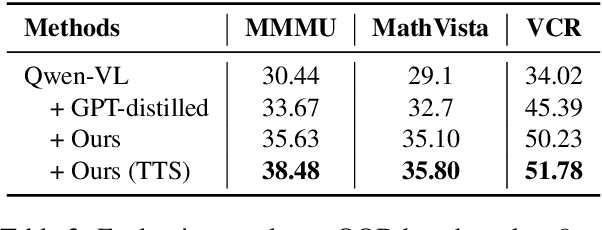
Abstract:Chain-of-thought (CoT) has proven to improve the reasoning capability of large language models (LLMs). However, due to the complexity of multimodal scenarios and the difficulty in collecting high-quality CoT data, CoT reasoning in multimodal LLMs has been largely overlooked. To this end, we propose a simple yet effective self-training framework, R3V, which iteratively enhances the model's Vision-language Reasoning by Reflecting on CoT Rationales. Our framework consists of two interleaved parts: (1) iteratively bootstrapping positive and negative solutions for reasoning datasets, and (2) reflection on rationale for learning from mistakes. Specifically, we introduce the self-refine and self-select losses, enabling the model to refine flawed rationale and derive the correct answer by comparing rationale candidates. Experiments on a wide range of vision-language tasks show that R3V consistently improves multimodal LLM reasoning, achieving a relative improvement of 23 to 60 percent over GPT-distilled baselines. Additionally, our approach supports self-reflection on generated solutions, further boosting performance through test-time computation.
AgentStore: Scalable Integration of Heterogeneous Agents As Specialized Generalist Computer Assistant
Oct 24, 2024Abstract:Digital agents capable of automating complex computer tasks have attracted considerable attention due to their immense potential to enhance human-computer interaction. However, existing agent methods exhibit deficiencies in their generalization and specialization capabilities, especially in handling open-ended computer tasks in real-world environments. Inspired by the rich functionality of the App store, we present AgentStore, a scalable platform designed to dynamically integrate heterogeneous agents for automating computer tasks. AgentStore empowers users to integrate third-party agents, allowing the system to continuously enrich its capabilities and adapt to rapidly evolving operating systems. Additionally, we propose a novel core \textbf{MetaAgent} with the \textbf{AgentToken} strategy to efficiently manage diverse agents and utilize their specialized and generalist abilities for both domain-specific and system-wide tasks. Extensive experiments on three challenging benchmarks demonstrate that AgentStore surpasses the limitations of previous systems with narrow capabilities, particularly achieving a significant improvement from 11.21\% to 23.85\% on the OSWorld benchmark, more than doubling the previous results. Comprehensive quantitative and qualitative results further demonstrate AgentStore's ability to enhance agent systems in both generalization and specialization, underscoring its potential for developing the specialized generalist computer assistant. All our codes will be made publicly available in https://chengyou-jia.github.io/AgentStore-Home.
Interactive Evolution: A Neural-Symbolic Self-Training Framework For Large Language Models
Jun 17, 2024

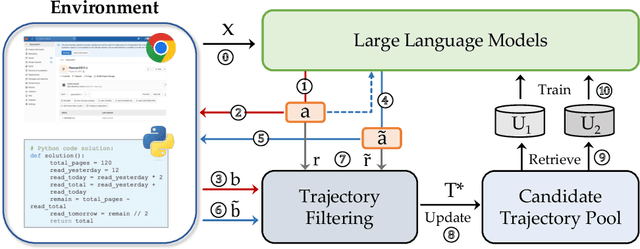
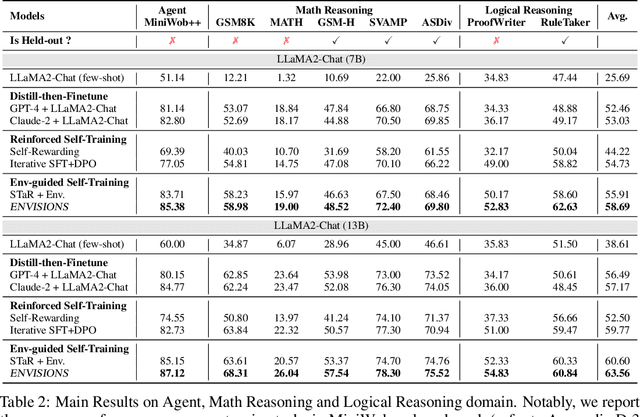
Abstract:One of the primary driving forces contributing to the superior performance of Large Language Models (LLMs) is the extensive availability of human-annotated natural language data, which is used for alignment fine-tuning. This inspired researchers to investigate self-training methods to mitigate the extensive reliance on human annotations. However, the current success of self-training has been primarily observed in natural language scenarios, rather than in the increasingly important neural-symbolic scenarios. To this end, we propose an environment-guided neural-symbolic self-training framework named ENVISIONS. It aims to overcome two main challenges: (1) the scarcity of symbolic data, and (2) the limited proficiency of LLMs in processing symbolic language. Extensive evaluations conducted on three distinct domains demonstrate the effectiveness of our approach. Additionally, we have conducted a comprehensive analysis to uncover the factors contributing to ENVISIONS's success, thereby offering valuable insights for future research in this area. Code will be available at \url{https://github.com/xufangzhi/ENVISIONS}.
PathReasoner: Modeling Reasoning Path with Equivalent Extension for Logical Question Answering
May 29, 2024Abstract:Logical reasoning task has attracted great interest since it was proposed. Faced with such a task, current competitive models, even large language models (e.g., ChatGPT and PaLM 2), still perform badly. Previous promising LMs struggle in logical consistency modeling and logical structure perception. To this end, we model the logical reasoning task by transforming each logical sample into reasoning paths and propose an architecture \textbf{PathReasoner}. It addresses the task from the views of both data and model. To expand the diversity of the logical samples, we propose an atom extension strategy supported by equivalent logical formulas, to form new reasoning paths. From the model perspective, we design a stack of transformer-style blocks. In particular, we propose a path-attention module to joint model in-atom and cross-atom relations with the high-order diffusion strategy. Experiments show that PathReasoner achieves competitive performances on two logical reasoning benchmarks and great generalization abilities.
 Add to Chrome
Add to Chrome Add to Firefox
Add to Firefox Add to Edge
Add to Edge